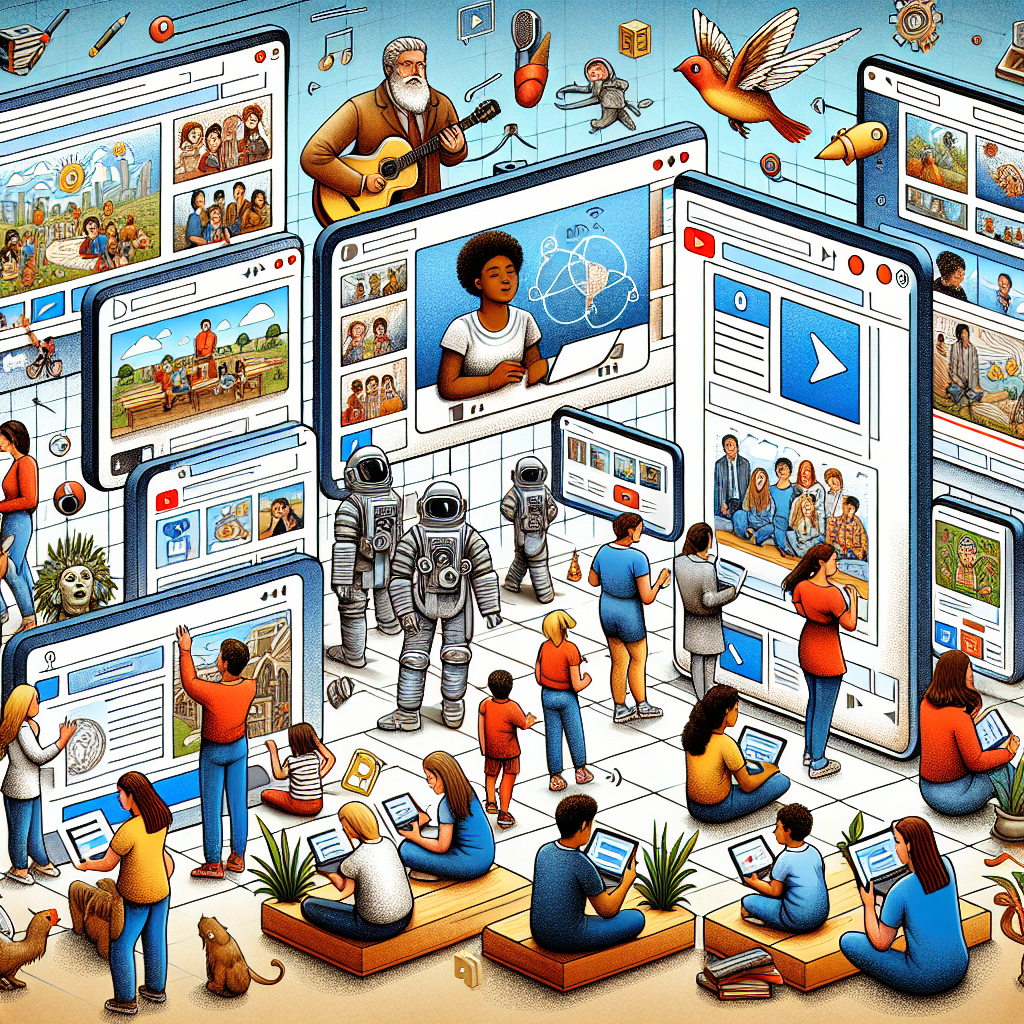In today’s digital age, the availability of educational content has never been more accessible thanks to streaming platforms dedicated to learning. From interactive videos to informative documentaries, these platforms offer a wealth of knowledge at our fingertips. Join us as we delve into the best streaming services tailored for educational content, where endless opportunities for personal growth and development await. Whether you’re a student looking to supplement your studies or a lifelong learner seeking to expand your horizons, these platforms offer a diverse range of subjects and resources to cater to your educational needs. Let’s embark on a journey of discovery and knowledge together.
Understanding Streaming Platforms for Educational Content
Streaming platforms refer to online services that deliver content over the internet in real-time, allowing users to access and consume videos, audio, and other media instantly without the need for downloading. When it comes to educational content, these platforms play a crucial role in providing learners with access to a vast array of resources, courses, and materials to enhance their knowledge and skills.
Definition of streaming platforms
- Streaming platforms are digital platforms that enable the distribution and playback of educational content through the internet.
- They utilize technologies such as video streaming, live broadcasting, and on-demand services to deliver educational materials to users.
- Examples of popular streaming platforms for educational content include Coursera, Udemy, Khan Academy, and TED-Ed.
Importance of educational content on streaming platforms
- Educational content on streaming platforms offers flexible learning opportunities for individuals of all ages and backgrounds.
- It allows learners to access high-quality resources from experts and educators worldwide, breaking down geographical barriers to education.
- The interactive nature of educational content on streaming platforms engages users and promotes active learning, enhancing retention and understanding of the material.
How streaming platforms are revolutionizing education
- Streaming platforms have democratized education by making it more accessible and affordable for learners globally.
- They provide personalized learning experiences through features such as progress tracking, quizzes, and discussion forums.
- The convenience of streaming platforms allows users to learn at their own pace and schedule, catering to different learning styles and preferences.
In conclusion, streaming platforms for educational content have transformed the way we acquire knowledge and skills, offering a wealth of resources and opportunities for lifelong learning and personal development.
Top Streaming Platforms for Educational Content

1. Khan Academy
Khan Academy is a widely recognized streaming platform that offers a plethora of educational content for learners of all ages. It stands out for its user-friendly interface, extensive subject coverage, and personalized learning experience.
Features and Benefits
– Khan Academy provides free access to a vast library of educational videos, exercises, and resources.
– The platform offers personalized learning paths based on the user’s proficiency level and learning goals.
– Users can track their progress, earn badges, and participate in challenges to stay motivated.
– Khan Academy also includes tools for teachers to monitor student performance and customize lessons accordingly.
Subjects Covered
– Khan Academy covers a wide range of subjects, including math, science, economics, history, computer programming, and more.
– Each subject is divided into various topics with in-depth explanations and interactive exercises to enhance understanding.
– The platform is suitable for learners from kindergarten to college level, making it a versatile resource for students at different academic stages.
User Experience
– The interface of Khan Academy is intuitive and easy to navigate, making it accessible for users with varying levels of technological proficiency.
– Learners can access content on Khan Academy from any device with an internet connection, allowing for seamless learning experiences.
– The platform incorporates gamification elements to engage users and make learning more enjoyable and interactive.
– Khan Academy also provides discussion forums and community support for users to collaborate, ask questions, and share knowledge with peers.
2. Coursera
Top Streaming Platforms for Educational Content
Coursera is a widely recognized online platform that offers a vast array of educational content from top universities and organizations worldwide.
Overview of the platform:
– Coursera provides access to thousands of courses covering a diverse range of subjects, including technology, business, humanities, and more.
– The platform is known for its high-quality video lectures, interactive quizzes, and peer-graded assignments, creating an engaging learning experience for users.
– With a user-friendly interface, Coursera allows learners to track their progress, participate in discussion forums, and interact with instructors and fellow students.
Courses available:
– Coursera offers courses in various formats, including self-paced courses, guided projects, specializations, and online degrees.
– Users can explore topics such as data science, programming, marketing, finance, and many others, catering to different interests and skill levels.
– The platform collaborates with top universities like Stanford, Yale, and Duke, ensuring the credibility and relevance of the course content.
Certification options:
– Upon completing a course on Coursera, learners have the opportunity to earn a certificate of completion, showcasing their newfound skills and knowledge.
– Coursera also provides specialization certificates and even online degrees in partnership with accredited institutions, offering learners the chance to enhance their credentials and advance their careers.
– The certificates obtained from Coursera are recognized by employers globally, adding value to the learning experience on the platform.
3. Udemy
Udemy, a prominent player in the online education sphere, offers a diverse array of courses catering to a wide range of interests and disciplines. Boasting a vast library of educational content, Udemy provides users with the flexibility to explore various subjects at their own pace.
Platform Overview:
Udemy’s intuitive platform design facilitates seamless navigation for users of all levels. The platform’s user-friendly interface makes it easy to search for courses, track progress, and engage with course materials. Additionally, Udemy offers mobile compatibility, enabling learners to access content on-the-go.
Instructor Quality:
One of Udemy’s standout features is its pool of instructors, comprising industry experts and professionals. These instructors bring real-world experience and expertise to their courses, enhancing the overall learning experience for students. Learners benefit from the diverse perspectives and insights shared by Udemy’s esteemed instructors.
Course Diversity:
Udemy prides itself on its extensive course selection, covering topics ranging from technology and business to arts and personal development. Whether learners are looking to acquire new skills or enhance existing knowledge, Udemy’s diverse course offerings cater to a broad audience. Additionally, the platform regularly updates its course catalog to reflect emerging trends and industry developments.
Factors to Consider When Choosing a Streaming Platform
When selecting a streaming platform for educational content, several factors should be taken into account to ensure the best learning experience. Here are some key considerations:
-
Cost comparison:
- It is essential to compare the subscription costs of different streaming platforms to determine the most cost-effective option.
- Some platforms offer tiered pricing plans with varying features, so it’s crucial to assess the value for money based on your educational needs.
-
User interface and experience:
- The user interface plays a significant role in the overall usability of a streaming platform.
- Look for platforms with intuitive navigation, clear categorization of content, and customizable settings to enhance the learning experience.
-
Accessibility and compatibility:
- Accessibility features such as closed captions, multiple language support, and compatibility with various devices are vital for accommodating diverse learners.
- Ensure that the streaming platform is compatible with your preferred devices, whether it’s a laptop, tablet, or smartphone, to access educational content anytime, anywhere.
-
Interactive features:
- Interactive elements like quizzes, discussion forums, and virtual labs can greatly enrich the educational content and promote active engagement.
- Consider platforms that offer collaborative tools for group projects and real-time interactions with instructors to foster a dynamic learning environment.
-
Reviews and testimonials:
- Before committing to a streaming platform, read reviews and testimonials from other users to gauge their satisfaction level.
- Pay attention to feedback on the platform’s content quality, customer support, and overall reliability to make an informed decision on its suitability for educational purposes.

Utilizing Streaming Platforms for Different Learning Styles
When it comes to educational content, catering to different learning styles is essential for effective comprehension and retention. Streaming platforms offer a versatile way to deliver educational material that can accommodate various learning preferences. Understanding the different learning styles can help educators tailor their content to reach a wider audience.
Visual Learners
Visual learners process information best when it is presented in a visual format such as images, charts, and videos. Streaming platforms can cater to visual learners by offering a wide range of visual content, including educational videos, animations, and infographics. These platforms provide a visually stimulating environment that can enhance the learning experience for visual learners.
Auditory Learners
Auditory learners prefer to absorb information through listening and speaking. Streaming platforms can support auditory learners by providing audio-based content such as podcasts, interviews, and lectures. These platforms enable auditory learners to engage with educational material through sound, allowing them to focus on the spoken word and enhance their listening skills.
Kinesthetic Learners
Kinesthetic learners learn best through hands-on experiences and physical activities. While streaming platforms may seem more geared towards visual and auditory content, they can still benefit kinesthetic learners by offering interactive simulations, virtual labs, and practical demonstrations. These hands-on experiences can help kinesthetic learners engage with the material in a more tangible way, promoting better understanding and retention.
Multimodal Learners
Multimodal learners benefit from a combination of different learning styles, incorporating visual, auditory, and kinesthetic elements into their learning experience. Streaming platforms are well-suited for multimodal learners as they offer a diverse range of content formats that cater to various preferences. By providing a mix of videos, podcasts, interactive activities, and other multimedia resources, these platforms can effectively engage and support multimodal learners in their educational journey.
In conclusion, streaming platforms play a crucial role in accommodating different learning styles by offering a variety of content formats that appeal to visual, auditory, kinesthetic, and multimodal learners. Educators can leverage these platforms to create a more inclusive and engaging learning environment that meets the diverse needs of their students.
Challenges and Misconceptions Surrounding Educational Content on Streaming Platforms
Quality of content
- One of the primary challenges facing educational content on streaming platforms is ensuring the quality of the materials available. Without strict oversight or standardized guidelines, there is a risk of inconsistent or misleading information being presented as educational content.
- Moreover, the lack of regulation can make it difficult for viewers to discern between reputable sources and unverified resources, potentially leading to a dilution of the educational experience.
- In an era where misinformation is rampant, maintaining high standards of content quality is crucial to upholding the integrity of educational streaming platforms.
Lack of accreditation
- Another common misconception surrounding educational content on streaming platforms is the issue of accreditation. While traditional educational institutions are often accredited by recognized bodies, online platforms may not adhere to the same standards.
- This lack of accreditation can raise doubts about the validity and credibility of the educational content offered, making it challenging for viewers to trust the information being presented.
- Without proper accreditation measures in place, educational streaming platforms may struggle to gain recognition as legitimate sources of learning.
Overreliance on technology
- With the increasing integration of technology into educational content on streaming platforms, there is a concern about overreliance on digital tools and platforms for learning.
- While technology can enhance the learning experience by providing interactive and engaging content, an excessive dependence on virtual environments may detract from critical thinking and analytical skills development.
- Balancing the benefits of technology with traditional pedagogical approaches is essential to ensure that educational content on streaming platforms remains effective and meaningful.
Potential distractions
- One of the challenges educators face when delivering content on streaming platforms is the potential for distractions. Unlike traditional classroom settings, online environments can be filled with external stimuli that may divert learners’ attention.
- From notifications and pop-up ads to the temptation of multitasking, the risk of distracting elements can hinder the focus and engagement of viewers, impacting the effectiveness of the educational content being delivered.

- Addressing these potential distractions requires designing content that captures and maintains viewers’ attention, fostering an immersive and productive learning experience.
The Future of Educational Content on Streaming Platforms
Advancements in technology:
- Enhanced Interactivity: Streaming platforms are increasingly incorporating interactive features such as quizzes, polls, and virtual simulations to engage learners actively.
- Artificial Intelligence: Utilizing AI algorithms allows for personalized recommendations, adaptive learning paths, and real-time feedback to enhance the learning experience.
- Virtual Reality and Augmented Reality: Integration of VR and AR technologies into educational content on streaming platforms offers immersive and experiential learning opportunities.
Personalized learning experiences:
- Data Analytics: Streaming platforms leverage data analytics to track user progress, preferences, and performance, enabling the delivery of tailor-made content based on individual learning styles.
- Adaptive Learning: Algorithms on these platforms adjust the difficulty and pace of content delivery to match the learner’s proficiency level, fostering a personalized learning journey.
- Microlearning: Bite-sized lessons and targeted content recommendations cater to the specific knowledge gaps and interests of learners, promoting continuous and personalized education.
Integration with traditional education systems:
- Blended Learning Approaches: Streaming platforms complement traditional classroom instruction by offering supplementary resources, flipped classroom models, and remote learning options for a more holistic educational experience.
- Professional Development: Educators can access professional development courses, workshops, and certifications on streaming platforms to enhance their teaching skills and stay updated with the latest pedagogical trends.
- Collaborative Tools: Features like discussion forums, group projects, and online communities facilitate collaboration among students and educators, bridging the gap between physical and virtual learning environments.
Potential impact on the future of education:
- Global Accessibility: Streaming platforms democratize access to quality educational content, breaking down geographical barriers and providing learning opportunities to individuals worldwide.
- Lifelong Learning: The convenience and flexibility offered by these platforms encourage a culture of lifelong learning, where individuals can acquire new skills and knowledge at their own pace and convenience.
- Innovative Pedagogical Practices: The integration of streaming platforms in education encourages experimentation with innovative teaching methods, fostering creativity, critical thinking, and problem-solving skills among learners.
FAQs: Exploring the Best Streaming Platforms for Educational Content
What are some popular streaming platforms for educational content?
Some popular streaming platforms for educational content include Coursera, Khan Academy, Udemy, and Skillshare. These platforms offer a wide range of courses on various subjects such as programming, languages, business, and more, taught by industry experts and professors from top universities.
Are these platforms free to use?
Most of these streaming platforms offer both free and paid courses. While some courses may be available for free, others require a paid subscription or one-time fee to access. Users can choose the type of course that best fits their budget and learning goals.
How do I know if a course on these platforms is right for me?
Before enrolling in a course on a streaming platform, you can usually preview the course curriculum, read reviews from other students, and view a sample lesson to get a sense of the instructor’s teaching style. This can help you determine if the course aligns with your learning preferences and goals.
Can I earn certifications or degrees from these streaming platforms?
Many streaming platforms offer certificates of completion for courses, which can be a valuable addition to your resume or LinkedIn profile. Some platforms also offer online degrees or specializations in partnership with universities, allowing you to earn a recognized credential in a specific field of study.